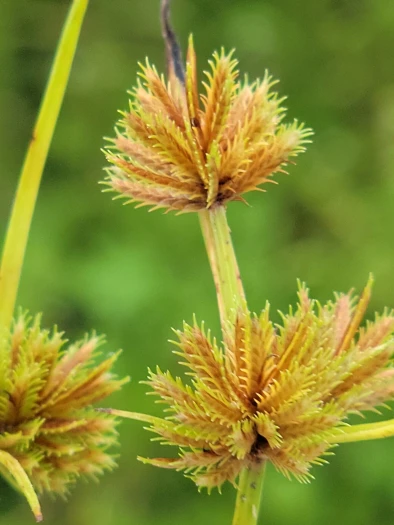Coastal Plain Flatsedge
(Cyperus cuspidatus)
Coastal Plain Flatsedge (Cyperus cuspidatus)
/
/

Jay Horn
CC BY 4.0
Image By:
Jay Horn
Recorded By:
Copyright:
CC BY 4.0
Copyright Notice:
Photo by: Jay Horn | License Type: CC BY 4.0 | License URL: http://creativecommons.org/licenses/by/4.0/ | Rights Holder: Jay Horn | Publisher: iNaturalist | Date Created: 2021-09-11T17:25:36-07:00 |










Estimated Native Range
Climate Requirements
| • Precipitation | 52" - 62" |
| • High Temp. | 84°F - 99°F |
| • Low Temp. | 42°F - 70°F |
Summary
Cyperus cuspidatus, commonly known as coastal plain flatsedge, is an annual sedge that is native to a wide range of habitats including seasonally dry tropical areas, open woodlands, grasslands, and along waterways in Africa, Asia, the Americas, and Australia. It typically grows 1 to 6 inches high with a tufted growth form. The plant produces inconspicuous green-yellow-brown flowers from February to August, which are not particularly showy but are interesting upon close inspection. In its native range, it often occupies stony red sand-loam soils over sandstone, particularly in Queensland, Northern Territory, and the Kimberley region of Western Australia.
Coastal plain flatsedge is valued for its ability to thrive in challenging conditions, such as poor, dry soils and areas with fluctuating water levels. It is often used in restoration projects to stabilize soil and prevent erosion, especially in riparian zones. For cultivation, it requires minimal care, tolerating full sun to part shade and preferring well-drained soils. While not commonly used in ornamental horticulture, it can be an interesting addition to naturalistic plantings and rain gardens. Its ability to adapt to a range of soil types and moisture levels makes it a versatile plant for challenging sites.CC BY-SA 4.0
Coastal plain flatsedge is valued for its ability to thrive in challenging conditions, such as poor, dry soils and areas with fluctuating water levels. It is often used in restoration projects to stabilize soil and prevent erosion, especially in riparian zones. For cultivation, it requires minimal care, tolerating full sun to part shade and preferring well-drained soils. While not commonly used in ornamental horticulture, it can be an interesting addition to naturalistic plantings and rain gardens. Its ability to adapt to a range of soil types and moisture levels makes it a versatile plant for challenging sites.CC BY-SA 4.0
Plant Description
- Plant Type: Grass
- Height: 1.5-2.5 feet
- Width: 1-2 feet
- Growth Rate: Moderate
- Flower Color: N/A
- Flowering Season: Summer
- Leaf Retention:
Growth Requirements
- Sun: Full Sun, Part Shade
- Water: High
- Drainage: Medium, Slow, Standing
Common Uses
Erosion Control, Low Maintenance, Water Garden
Natural Habitat
Native to a wide range of habitats including seasonally dry tropical areas, open woodlands, grasslands, and along waterways
Other Names
Common Names: Clustered Cyperus, Clustered Galingale
Scientific Names: Cyperus cuspidatus, Cyperus angustifolius, Cyperus angustifolius, Cyperus capitatus, Cyperus contractus, Cyperus cuspidatus f. angustifolius, Cyperus cuspidatus f. exiguus, Cyperus cuspidatus subsp. angustifolius, Cyperus cuspidatus subsp. burchellii
GBIF Accepted Name: Cyperus cuspidatus